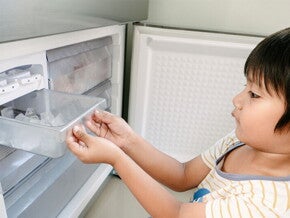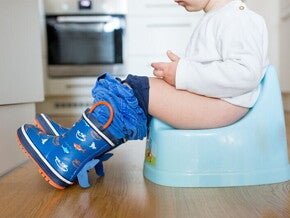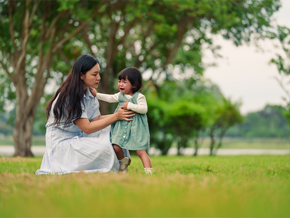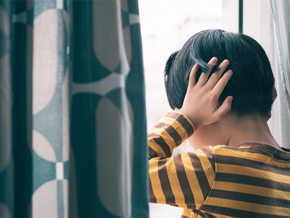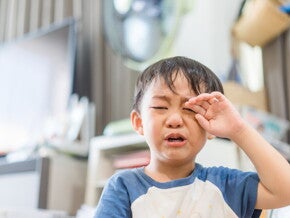
Food allergies can lead to some scary reactions, like swelling, trouble breathing, or even a trip to the ER. For many kids, though, the first signs are much quieter: a rash, a patch of dry skin, or some unexpected itchiness. But you can confuse these skin-related food allergy symptoms for something else.
How can you tell if your child’s rash is from food they ate and not, let's say, related to teething, extreme heat, or viral infection? Here’s a guide to help you figure it out.
What Is Food Allergy?
A food allergy occurs when your child's immune system mistakenly sees a specific food as a threat. As a result, it launches an "attack," releasing chemicals, like histamine, into their body. It's these chemicals that cause food allergy symptoms, which typically affect the skin. But severe allergy attacks can also lead to breathing problems and digestive issues.
If you or your partner has a food allergy, asthma, eczema, or hay fever (allergic rhinitis), the risk of your child developing a food allergy increases. And if mom and dad have food allergies, that risk goes up even more, especially if you're both sensitive to the same thing. You can check your baby's risk with this allergy calculator.
That said, kids can still develop allergies even if there’s no family history. Food allergies tend to affect babies and toddlers more. Environmental factors, including dust, air pollution, and exposure to tobacco smoke, can also increase the risk of your child developing food allergy.
Skin Reactions Due to Food Allergy
Food allergy symptoms can show up within minutes—or take a few hours to appear. Here are five ways they manifest.
1. Mild skin reactions
These three are the common early signs of allergies:
- Rash: Any change in the skin’s appearance, such as bumps, blotches, or dry patches.
- Itching: May occur alone or with a rash. Some kids describe it as a tingling or prickly feeling.
- Redness: Often a sign of inflammation, especially on the cheeks, arms, or around the mouth.
Good to know: Mild skin symptoms often clear up on their own, but they don’t always mean it's a food allergy. There are several other potential causes, including medications, insect bites, or pre-existing skin conditions.
2. Hives
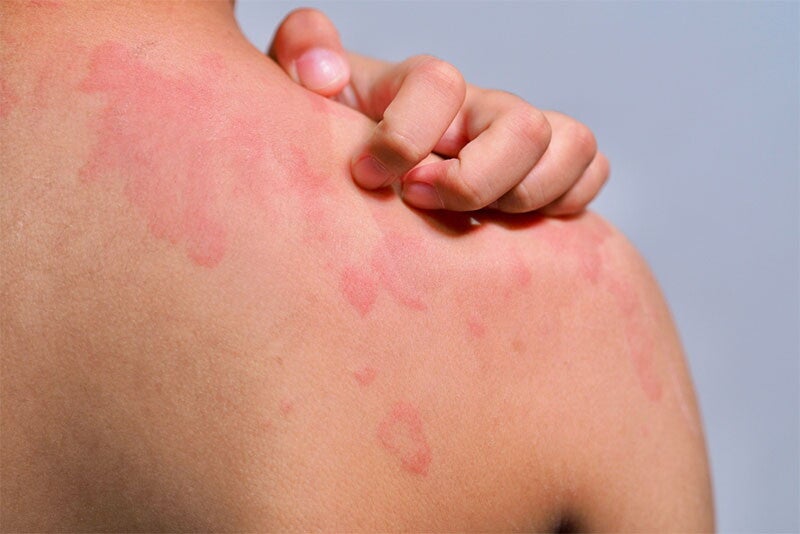
Children who are allergic to eggs or shellfish may develop hives similar to these welts.
Urticaria or hives are one of the most common food allergy symptoms on the skin. They appear as itchy red or skin-colored bumps that look like bug bites on an area of the body. Hives may pop up minutes to an hour after your child eats an allergen. But they also come and go over short periods.
Good to know: Scratching tends to worsen the itching. Hives, which have clear edges, will also turn white when you press their center. The American College of Allergy, Asthma & Immunology (ACAAI) calls it "blanching." Hives are not contagious or life-threatening, but they can become chronic.
3. Eczema
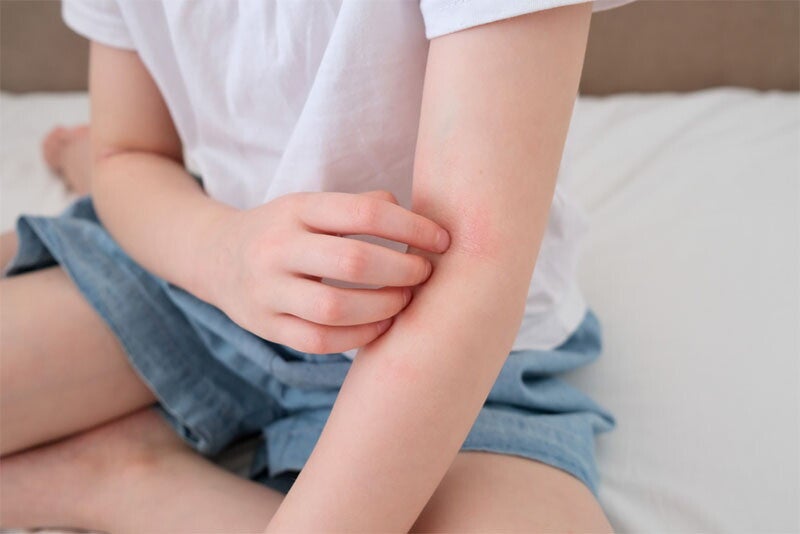
Some food allergy symptoms like itchiness can happen within seconds to minutes of eating.
Eczema, also known as atopic dermatitis, is typically the first stage of what dermatologists refer to as the "atopic march," a pattern of how allergic conditions tend to develop in children over time. Atopic march often starts with eczema, especially among babies, and then progresses to other issues, including food allergy and asthma, later on.
The Australasian Society of Clinical Immunology and Allergy says food allergy is common among babies and young children with atopic dermatitis. Dry, scaly, and inflamed patches of skin, which can feel extremely itchy, mark this condition.
Good to know: Food allergy doesn't cause atopic dermatitis. But if your child has the skin condition already, certain foods can trigger or worsen eczema flare-ups. You may notice your child's skin becoming redder, itchier, and more inflamed within 30 minutes of eating.
4. Swelling
Angioedema, or swelling, can sometimes be confused with hives or occur alongside them. The fluid build-up can occur quickly on your child's lips, eye area, hands, feet, throat, or other parts of the body. Sometimes, vomiting or coughing can accompany the swelling.
Good to know: While mild puffiness can be part of a skin reaction to a food allergen, swelling combined with other symptoms, such as trouble breathing, requires urgent care.
5. Anaphylaxis
Anaphylaxis is a life-threatening allergic reaction and requires immediate emergency treatment. Its symptoms include:
- Difficulty breathing due to airway swelling
- Widespread hives
- Swelling
- Rapid or weak pulse
- Dizziness or loss of consciousness
- Severe drop in blood pressure (anaphylactic shock)
Good to know: Anaphylaxis can rapidly progress to respiratory failure or cardiac arrest within minutes to hours after exposure to an allergen. If your child experiences any of its symptoms, bring them to the emergency room ASAP.
Common Food Allergy Triggers in Kids
Children with food allergies do not always experience the same symptoms or have the same triggers. However, research does show patterns.
A Pediatric Allergy and Immunology study reports that in Japan, the most common food allergy symptoms for babies under 1 year old were linked to:
- Hen’s eggs, the top allergen responsible for over 30% of reactions in that country
- Cow’s milk, especially for eczema flare-ups and hives
- Tree nuts, particularly walnuts
An allergy guide from the Philippine Society of Allergy, Asthma and Immunology shows similar results with the addition of soy and wheat as allergens.
Most kids outgrow their allergies to these foods. But food allergens like shellfish can have a lifelong impact. Shellfish allergies are common among older kids in the Philippines, Singapore, and Vietnam, a study in Allergy, Asthma and Immunology Research shows.
How to Relieve Food Allergy Symptoms
If you think your child is having a mild skin reaction to food, stop giving the suspected food right away. Monitor symptoms to see if they get worse or improve, and apply these home remedies:
Avoid scratching
This is easier said than done, of course, with a child who's already crying in discomfort. But scratching can worsen the rash, break the skin, and lead to infection. Keep your child's nails trimmed short, and consider soft cotton mittens or gloves for babies or toddlers at night.
Apply cool compresses
Put a cool, damp cloth or an ice pack wrapped in a towel to the itchy or red areas for 10-15 minutes at a time. For more widespread irritation, a cool or lukewarm bath can be incredibly soothing. Avoid hot water, as it can make itching worse. Ask your doctor about over-the-counter options to relieve mild itching.
Dress your child in loose, soft clothing
Opt for breathable fabrics like cotton, which can help keep the skin cool. Tight or rough clothing can rub against irritated skin, exacerbating itching and discomfort.
How to Help Your Child Who Has Food Allergy
The best "home remedy" for allergies is to identify the offending food and avoid it. Tracking what your child eats—and when symptoms appear—can help your pediatrician or allergist identify patterns.
Call your pediatrician if these situations persist.
- The rash keeps coming back after eating certain foods.
- Your child has eczema that isn't improving with usual treatments.
- You're unsure what's causing the skin reaction.
However, call emergency services immediately if your child:
- Has difficulty breathing
- Shows severe skin reactions
- Has swelling of the lips, tongue, or face
- Starts coughing, vomiting, or looking pale after eating
Trust your instincts, and don’t hesitate to reach out to your doctor. Home remedies for food allergy symptoms help with comfort, but they don’t replace medical advice or diagnosis.
Does your child have a food allergy? Share how you're dealing with it on Parenteam's Moms and Dads Facebook group!
References
ACAAI Patient. “Skin Allergies | Causes, Symptoms & Treatment | ACAAI Public Website,” January 23, 2024. Accessed June 16, 2025. https://acaai.org/allergies/allergic-conditions/skin-allergy/.
Wong, Gary Wing-Kin. “Food Allergies Around the World.” Frontiers in Nutrition 11 (June 13, 2024). https://doi.org/10.3389/fnut.2024.1373110.
Daley, Sharon F., Claudia M. Lopez, and Magda D. Mendez. “Food Allergies.” StatPearls - NCBI Bookshelf, May 5, 2025. Accessed June 16, 2025. https://www.ncbi.nlm.nih.gov/books/NBK482187/.
Mayo Clinic. “Food Allergy - Symptoms and Causes,” n.d. https://www.mayoclinic.org/diseases-conditions/food-allergy/symptoms-causes/syc-20355095.











